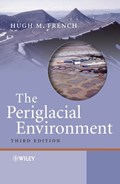The Periglacial Environment, Third Edition**,** provides an authoritative overview of the worldâ??s cold, non-glacial environments. Emphasis is placed upon the North American and Eurasian polar lowlands, but examples are also drawn from Antarctica, the Qinghai-Xizang (Tibet) Plateau, and the northern mid-latitudes. First published in 1976 and subsequently revised in 1996, the text has been the international standard for over 30 years.
The Third Edition continues to be a personal interpretation of the frost-induced conditions, geomorphic processes, and landforms that typify periglacial environments. The text is divided into four parts. Part One discusses the periglacial concept and its interactions with geomorphology, geocryology and Quaternary science. It also outlines the range and variability of periglacial climates and the degree to which landscapes are in geomorphic equilibrium with prevailing periglacial conditions. Part Two describes present-day terrain that is either underlain by permafrost or experiencing intense frost action. The roles played by cryogenic weathering, ground ice, mass wasting, running water, wind action, snow and ice, and coastal processes are systematically analysed. Part Three summarizes evidence for the existence of periglacial conditions during the cold periods of the Pleistocene, with special reference to the mid-latitudes of Europe and North America. Part Four illustrates the geotechnical problems associated with human activity and resource development in periglacial environments, and discusses the potential impact of global climate change in the northern high latitudes.
This excellent textbook is an invaluable resource for second and third year undergraduate students of Physical Geography, Geology, Environmental Science and Earth Science. The Periglacial Environment, Third Edition is also an informative reading for professionals, researchers and lecturers working and teaching in the field.

